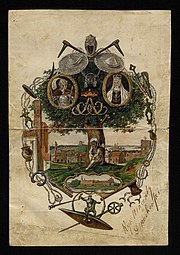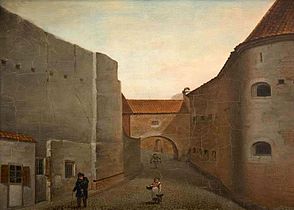This article needs additional citations for
verification. (May 2016) |


Wincenty Dmochowski or Dmóchowski ( Lithuanian: Vincentas Dmachauskas, Belarusian: Vincent Dmachoŭski; born 1805/1807, Naharodavičy, Dzyatlava District, died 6 March 1862, Vilnius) was a Polish-Lithuanian painter born in modern-day Belarus and scenographer in the Romantic style.
Biography
He was born to a landowning family in the village Samiszcze. His father was Ignacy Dmochowski, vice-marshal of Ashmyany county, and his mother was Maria Zenowicz. [1] After graduating from the public schools in Shchuchyn, he attended Vilnius University as a literature and fine arts student from 1826 to 1829. [1] There he studied painting with Jan Rustem and sculpture with Kazimierz Jelski. In 1830 he married Salomea Orłowska, daughter of Ignacy Orłowski, officer of the Polish army. [1]
After participating in the November Uprising, he was forced to abandon his studies and go into exile in Prussia to avoid persecution. [2]
Following an amnesty, he was able to return to Vilnius in 1837 and opened his own private painting school in 1840. Józef Marszewski was one of his best-known students. His son, Władysław, also became a well-known painter. [2]
Primarily known for landscapes, he also painted historical scenes, portraits and genre works focusing on rural interiors. He also created a series of canvases based on the poetry of Adam Mickiewicz, did restorations and executed some decorative work at a few sites, including Verkiai Palace and Vilnius Cathedral. On several occasions, he worked as a set designer, creating scenery for Halka by Stanisław Moniuszko and L'italiana in Algeri by Gioacchino Rossini, among others. [2]
In 1847, he painted a series of Lithuanian castles on behalf of the archaeologist, Eustachy Tyszkiewicz, which are some of his most familiar works. [2] Many of his paintings may be seen at the National Museum, Krakow.
Selected works
-
Crusaders Preparing to Attack
Punia Castle -
Medininkai Castle Ruins
-
Street in Vilnius
References
- ^ a b c Syrokomla 1862, p. 144.
- ^ a b c d Brief biography and appreciation @ Pawet.
Sources
Syrokomla, Władysław (1862). "Wincenty Dmóchowski". Kurier Wileński (in Polish). No. 18. Vilnius.
External links
![]() Media related to
Vincent Dmachoŭski at Wikimedia Commons
Media related to
Vincent Dmachoŭski at Wikimedia Commons
This article needs additional citations for
verification. (May 2016) |


Wincenty Dmochowski or Dmóchowski ( Lithuanian: Vincentas Dmachauskas, Belarusian: Vincent Dmachoŭski; born 1805/1807, Naharodavičy, Dzyatlava District, died 6 March 1862, Vilnius) was a Polish-Lithuanian painter born in modern-day Belarus and scenographer in the Romantic style.
Biography
He was born to a landowning family in the village Samiszcze. His father was Ignacy Dmochowski, vice-marshal of Ashmyany county, and his mother was Maria Zenowicz. [1] After graduating from the public schools in Shchuchyn, he attended Vilnius University as a literature and fine arts student from 1826 to 1829. [1] There he studied painting with Jan Rustem and sculpture with Kazimierz Jelski. In 1830 he married Salomea Orłowska, daughter of Ignacy Orłowski, officer of the Polish army. [1]
After participating in the November Uprising, he was forced to abandon his studies and go into exile in Prussia to avoid persecution. [2]
Following an amnesty, he was able to return to Vilnius in 1837 and opened his own private painting school in 1840. Józef Marszewski was one of his best-known students. His son, Władysław, also became a well-known painter. [2]
Primarily known for landscapes, he also painted historical scenes, portraits and genre works focusing on rural interiors. He also created a series of canvases based on the poetry of Adam Mickiewicz, did restorations and executed some decorative work at a few sites, including Verkiai Palace and Vilnius Cathedral. On several occasions, he worked as a set designer, creating scenery for Halka by Stanisław Moniuszko and L'italiana in Algeri by Gioacchino Rossini, among others. [2]
In 1847, he painted a series of Lithuanian castles on behalf of the archaeologist, Eustachy Tyszkiewicz, which are some of his most familiar works. [2] Many of his paintings may be seen at the National Museum, Krakow.
Selected works
-
Crusaders Preparing to Attack
Punia Castle -
Medininkai Castle Ruins
-
Street in Vilnius
References
- ^ a b c Syrokomla 1862, p. 144.
- ^ a b c d Brief biography and appreciation @ Pawet.
Sources
Syrokomla, Władysław (1862). "Wincenty Dmóchowski". Kurier Wileński (in Polish). No. 18. Vilnius.
External links
![]() Media related to
Vincent Dmachoŭski at Wikimedia Commons
Media related to
Vincent Dmachoŭski at Wikimedia Commons



